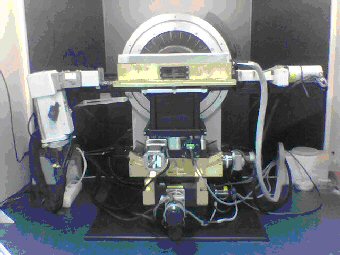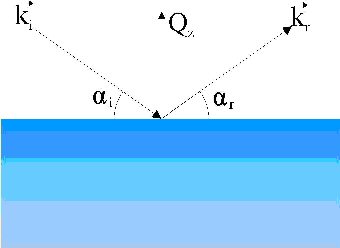X-Ray Reflectivity
Techniques: X-Ray Reflectivity
X-ray reflectivity at grazing incidence can be used to gain information about the electron density profile of an interface perpendicular to the interface. The experimental reflectivity curves can be compared with those calculated from theoretical considerations of the structure of the interface to give information such as the thickness or density of a monolayer film. The picture below shows a picture of the Bruker AXS D8 Advance, along with a sealed cell designed by Dr. R. M. J. Jacobs (Oxford) to allow the measurement of reflectivity curves over a range of temperatures. This is of particular use for our studies of PHASE TRANSITIONS in surface layers.

The geometry of a specular reflectivity measurement (αi = αr) is shown in the figure below. The momentum transfer, Qz, is along the surface normal. If the incident and reflected angles are not equal, we are measuring diffuse scattering from the interface. In this case, the momentum transfer has a non-zero component in the plane of the interface.
The reflection of x-rays from an interface occurs through scattering events due to the interaction of the incoming beam with the electrons present in material gathered at the interface. Therefore specular reflectivity measurements are sensitive to the electron density profile perpendicular to the interface, and can be used to yield information on the thickness, density and roughness of any layers present at the interface. Diffuse scattering gives information on correlations in the plane of the interface. A reflectivity curve from the surface of pure water is shown below. The red line is a theoretical fit to the data assuming 3Å interfacial roughness.

As with ELLIPSOMETRY and NEUTRON REFLECTION, x-ray reflectivity is an under-determined technique, and as such the successful analysis of experimental data is reliant upon the formation of realistic models which can be used as a basis for fitting.
